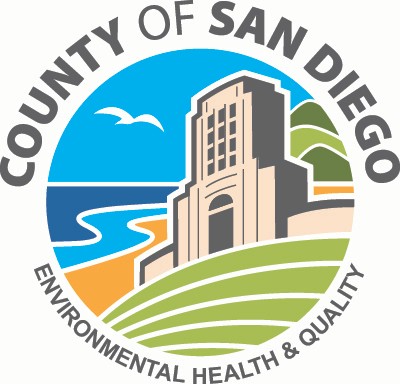The EPA Oil Spills Prevention
and Preparedness Regulations Webpage now includes a link to the
OECA webpage and March 26, 2020 memorandum for COVID-19 Implications
for EPA's Enforcement and Compliance Assurance Program.
California Aboveground Petroleum Storage Act
The Aboveground Petroleum Storage Act (APSA) applies to owners and
operators with a total storage capacity of 1,320 gallons* or more of
petroleum at a facility. The Department of Environmental Health and Quality
(DEHQ), Hazardous Materials Division (HMD) is the Certified Unified Program Agency (CUPA)
responsible for the regulatory inspections of all Tank Facilities
subject to APSA in the County of San Diego. The main purpose of the
APSA inspection program is to verify tank facilities have prepared and
are implementing a Federal Spill Prevention, Control, and
Countermeasure (SPCC) Plan.
In APSA, the term “petroleum” means crude oil, or a fraction
thereof, that is liquid at 60 degrees Fahrenheit temperature and 14.7
pounds per square inch absolute pressure. Please refer to the state law for additional information.
*Some facilities with less than 1,320 gallons of petroleum with a
Tank In An Underground Area (TIUGA) would be subject to APSA. Please
refer to the OSFM
Information on Tanks In Underground Areas (TIUGAs) webpage for
more information.
*Some facilities may be Conditionally Exempt from APSA requirements
if they are located on and operated by a farm, nursery, logging site,
or construction site and if they meet the conditions listed in HSC §25270.4.5(b).
Aboveground storage capacity of more than 10,000 gallons:
Large Tank Facilities, with a storage capacity of more than 10,000
gallons of oil must use a Professional Engineer to certify the SPCC
Plan. The USEPA provides resources and guidance on their website.
Aboveground storage capacity
of 10,000 gallons or less:
Tank Facilities with a total storage capacity
of ≥1,320 gallons* and <10,000 gallons of oil, with
limited or no oil releases, are considered "Qualified
Facilities" under the federal SPCC rule. There are two
types of qualified facilities, Tier I and Tier II. Qualified
Facilities may use ready-made templates to develop their
SPCC Plan and may self-certify their SPCC Plan. Tier I
facilities may prepare and self-certify their own SPCC
plan. U.S.
EPA SPCC Plan Template - Tier I Qualified
Facilities Tier II facilities may also prepare
and self-certify their own SPCC plan. SPCC
Plan Template - Tier II Qualified Facilities
Tanks in Underground Areas (TIUGAs): On October
2, 2015, Senate Bill SB-612 (Jackson) amended the definition
of a “Tank In An Underground Area” (TIUGA) and as of January
1, 2019, facilities with TIUGAs became subject to regulation
under APSA [HSC §25270.3]. Facilities with less than 1,320
gallons of total petroleum storage capacity that have one or
more TIUGAs must prepare and implement a Spill Prevention,
Control, and Countermeasures (SPCC) Plan. Please refer to the
following guidance documents for more information on
TIUGAs:
Laws
and Regulations: Tanks in Underground Areas
OSFM
Information on Tanks In Underground Areas (TIUGAs)
Monthly Checklist for TIUGA Facility with Less than 1,320
Gallons of Petroleum (Word | PDF)
Monthly Checklist for TIUGA Facility with Less than 1,320
Gallons of Petroleum (OSFM
Version) |
| |
New Aboveground Petroluem Storage Tank Regulations:
California has new APSA regulations
that came into effect on December 17, 2024, and are
found in the California Code of Regulations (CCR Title 19 Division
1. Chapter 11. Article 1 §1600-1616).
Until December 17, 2024, the APSA program
requirements were contained in state statute (HSC
Chapter §6.67 25270). The Office of the State
Fire Marshal (OSFM) submitted new APSA regulations to
the Office of Administrative Law (OAL) and requested
that they be made effective upon approval, which the
OAL granted on December 17, 2024.
How do the new APSA regulations affect your
business? -
All facilities subject to APSA must submit
information in the APSA Facility Element of
the California
Environmental Reporting Systems (CERS)
annually. Existing requirements state
that APSA facilities must certify their Hazardous
Materials Business Plan (HMBP) annually or submit a
Tank Facility Statement, so this new requirement
clarifies that the annual submittal should also
include the APSA Facility Information form in CERS
regardless of whether any of the information has
changed.
-
All
facilities subject to APSA must be
inspected. Certified
Unified Program Agencies (CUPAs) were previously
required to inspect APSA facilities with more than
10,000 gallons of petroleum storage capacity, and
local ordinance required County of San Diego
Hazardous Materials Division (HMD) (as the local
CUPA) to inspect APSA facilities with 1,320
gallons or more of petroleum storage and those
that are Conditionally Exempt. The new
regulations require HMD to also inspect APSA
facilities with less than 1,320 gallons of
petroleum storage which includes sites subject to
APSA because they have one or more Tanks in an
Underground Area (TIUGA).
- TIUGAs have been subject to APSA
requirements since January 1, 2018, and HMD has
been providing APSA compliance guidance since
that date. HMD is already inspecting sites with
TIUGAs for HMBP compliance and other CUPA
programs as applicable and will include the APSA
program scope during the next routine
inspection. Failure to prepare and implement an
SPCC Plan may result in violations.
- HMD
has been conducting initial inspections of
Conditionally Exempt APSA facilities to verify
they meet the criteria for the exemption and
will conduct subsequent routine inspections
every three years to ensure the criteria
continues to be met. Note that Conditionally
Exempt facilities include construction sites
that typically do not require a permit for more
than three years.
For
additional questions regarding APSA, please contact
Erin Thomas, APSA program technical lead, at erinr.thomas@sdcounty.ca.gov
or your local inspector.
For
assistance with CERS contact the CERS help desk at
858-505-6990 or your local inspector.
Additional APSA Information:
HMD
APSA Workshop 10/17/2024 - Slide Deck
Code
of Federal Regulations Part 112 – Oil Pollution
Prevention (SPCC Rule)
Federal
SPCC Requirements and Guidance
California
Health and Safety Code Chapter 6.67 Aboveground
Storage of Petroleum (APSA)
Office
of the State Fire Marshall (OSFM) and the APSA
Program For fire code requirements
on aboveground petroleum storage tank installation,
alteration, abandonment or removal, contact the
appropriate District
1 Fire Authority or for state owned/operated
facilities contact CAL
FIRE-OSFM Fire & Life Safety Division.
APSA
Requirements for Farms per Senate Bill 612
OSFM
Information Bulletin 14-0005 Addendum
01-29-2015 (pertains to Underground Storage Tanks
Being Sold As Aboveground Storage Tanks)
COVID-19
Implications for EPAs Enforcement and Compliance
Assurance Program (no longer in effect after Aug
31, 2020) | |






